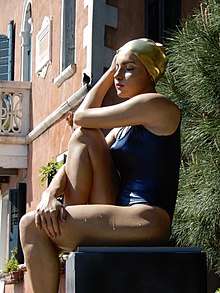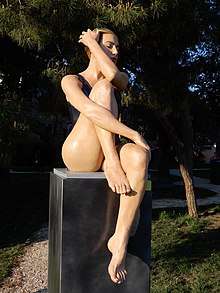The Midpoint
The Midpoint is a 2017 hyperrealist hand-patinated resin sculpture, created by New York contemporary artist Carole Feuerman. The life size three-dimensional artwork represents a young woman wearing a one-piece bathing suit and swim cap after just exiting the water, still dripping wet.[1]
| The Midpoint | |
|---|---|
 The Midpoint at Giardino della Marinaressa part of the 2017 Venice Biennale | |
| Artist | Carole Feuerman |
| Year | 2017 |
| Medium | Hand-Patinated Resin |
| Subject | Swimmer |
| Dimensions | 135 cm × 59 cm × 41 cm (53 in × 23 in × 16 in) |
| Location | Musée Imaginaire, Tübingen, Germany |
History

The Midpoint made its world debut in 2017 at Feuerman's solo showing at Giardino della Marinaressa park, during, but not part of the 57th Venice Biennale in Italy. Later in 2018, it appeared in her individual outdoor exhibition along the sea in Knokke-Heist, Belgium. In 2019, it arrived in Tübingen, Germany (near Stuttgart) to appear in the “Musée Imaginaire” where it is currently being exhibited.[2][3][4][5][6]
Creation

The sculpture, depicting French-Mexican actress Yadira Pascault Orozco as a swimmer, began with an extensive plaster-casting and molding process at Feuerman's Manhattan studio. Pascault Orozco and Feuerman had met, for the first time, the week before in Los Angeles at the opening of Feuerman's sculpture show entitled "Perception" at KM Finearts. Pascault Orozco flew out to New York several days later to begin a week-long process of being molded and cast by Feuerman and her team with plaster and fiberglass to make a sculpture of her likeness.[7][8]
Tübingen Controversy
In late 2019, Tübingen, Germany mayor Boris Palmer chose Feuerman's "The Midpoint" to appear at the “Musée Imaginaire” by SWR2 Hölderlinturm on the Neckar River. Later on, a heated dispute over the piece erupted in Tübingen.[9]
According to the German newspaper Wochenblatt Reutlinger, the mayor of Tübingen Mayor Boris Palmer, fell in love with the sculpture and, since there was no space in the town hall, he wants to permanently place it in front of the Tübingen River shorefront. "Midpoint" is the name of the object, created by the American sculptor Carole A. Feuerman. It shows a swimmer with a bathing cap who seems to have just emerged from the water. "I am convinced that this first work of art in public space will be a great asset for the Kunsthalle and the city, thanks to my initiative," he said.[10]
The city’s art commission and culture committee and local council had not been consulted and questioned the decision asking, Should a mermaid be installed on the shore of the Neckar river near the University of Tübingen, and if so, why?[11]
The art commission had found out about the planned sculpture only a few days before the cultural committee meeting, in which the local council and the public were informed. A well-founded statement in this short period was not possible. The press release published a short time later by the Kunsthalle caused irritation. It said: "The municipal art commission advised on the project and made a positive statement about the quality of the work." This was not the case. Cultural office director Dagmar Waizenegger said he doubted that the artwork would fit in Tübingen, while art historian Walter Springer that the work featured a highly stylized body image based on a defined ideal of beauty and that in comparison to other new hyper-realistic sculptural works, this is to be seen as an artistic anachronism. [12]
However current Kunsthalle curator/director, Dr. Nicole Fritz, strongly defended the acquisition of the sculpture proclaiming it as contemporary because it addresses the role of women. The woman is not portrayed as an object as in advertising, but rather confidently and self-determined in harmony with herself and nature. The young woman exudes self-confidence and serenity. “Midpoint” is contemporary because the work literally lifts the body onto the pedestal as an instance of self-assurance and, last but not least, throws the viewer back on their own physicality. Other members of the Tübingen arts community such as, AK München, Walter Springer and sculpture professor Olaf Metzel were also in favor of the acquisition.[13][14][15]
See also
References
- "Kommission: Kein hochrangiges Kunstwerk". 10 February 2020. Retrieved 28 April 2020.
- https://www.gwise.co.uk/Juicebox/Jb-Venice/index.html
- "Les nageuses de Carole Feuerman". Retrieved 11 Nov 2017.
- https://www.gwise.co.uk/Juicebox/Jb-Venice/index.html
- "Les nageuses de Carole Feuerman". Retrieved 11 Nov 2017.
- "Boris Palmer über die Tübinger „Nixe" von Carole Feuerman Museum im Kopf". Retrieved 14 Dec 2019.
- "Yadira Pascault Orozco: The Muse". Retrieved 9 Aug 2016.
- ""The Midpoint"]". Retrieved 1 Nov 2017.
- "SWR2 sammelt Lieblingsbilder von Promis in der Coronakrise". Retrieved 22 April 2020.
- https://www.swr.de/swr2/kunst-und-ausstellung/artikel-museum-im-kopf-lieblingsbilder-von-promis-in-der-coronakrise-100.html
- "Ziert das Neckargestade demnächst eine Plastik-Frau?". Retrieved 28 April 2020.
- "Tübingen streitet über Feuerman-Skulptur". Retrieved 12 Dec 2019.
- "Kommission: Kein hochrangiges Kunstwerk". 10 Feb 2020. Retrieved 28 April 2020.
- "Ziert das Neckargestade demnächst eine Plastik-Frau?". Retrieved 22 April 2020.
- "Kunst im öffentlichen Raum". Retrieved 5 Dec 2019.
External links
- The Midpoint - www.sculpture.org/